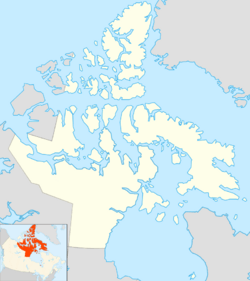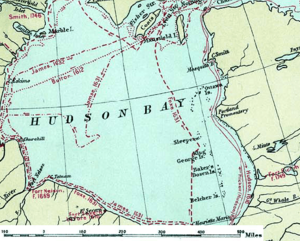Ottawa Islands facts for kids
|
Native name:
Arviliit or Arqvilliit
|
|
|---|---|
| Geography | |
| Location | Hudson Bay, Nunavik Marine Region |
| Coordinates | 59°30′N 80°25′W / 59.500°N 80.417°W |
| Archipelago | Canadian Arctic Archipelago |
| Total islands | 24 |
| Major islands | Booth Island, Bronson Island, Eddy Island, Gilmour Island, J. Gordon Island, Pattee Island, Perley Island |
| Highest elevation | 549 m (1,801 ft) |
| Administration | |
|
Canada
|
|
| Nunavik | |
| Demographics | |
| Population | Currently Uninhabited, access and harvest rights by Nunavik Inuit |
| Source: Ottawa Islands at Atlas of Canada | |
The Ottawa Islands are a group of 24 small islands in Canada's Hudson Bay. The Inuit people call them Arviliit or Arqvilliit. This name means "place where you see bowhead whales."
These islands are not currently lived on by people. They are located around 60 degrees North and 80 degrees West. Some of the main islands are Booth Island, Bronson Island, and Gilmour Island. Gilmour Island has the highest point, rising over 549 meters (1,800 feet).
The Ottawa Islands are near the northwest coast of Quebec's Ungava Peninsula. They used to be part of the Northwest Territories. In 1999, when Nunavut was created, they became Crown Land. This means they are owned by the government. The Nunavik Inuit have always used these islands. In 2007, they gained special rights to use the islands for hunting and fishing.
Exploring the Ottawa Islands
The Ottawa Islands are found on the rocky eastern coast of Hudson Bay. This large bay was first explored by Henry Hudson in 1610. He was looking for a shortcut to Asia, called the Northwest Passage.
Later, in 1631, another explorer named Luke Foxe sailed through the area. He mentioned islands that Henry Hudson supposedly named "Lancaster's Iles." However, historians have not found other records of Hudson using that name.
Foxe also named a small island "Ile Sleepe." This name later changed to "Sleeper Island" or "The Sleepers." These names might refer to all the islands between Lancaster and Ottawa Islands.
Amazing Animals of the Ottawa Islands
The Ottawa Islands are a very important place for many animals. They are a special breeding ground for a type of bird called the Hudson Bay Common Eider.
The waters around the islands are full of life. They are home to seals, walruses, and different kinds of whales. You can find bowhead whales and beluga whales here. The islands are also a key habitat for polar bears. Many waterfowl, like ducks and geese, also live and nest here.
In the past, people used to hunt bowhead whales around the Ottawa Islands. This commercial whaling began in 1765. Ships from the Hudson's Bay Company would hunt whales in these waters.




